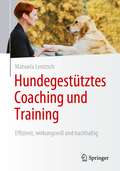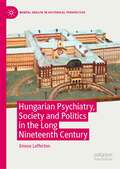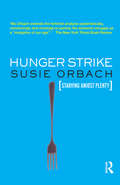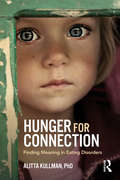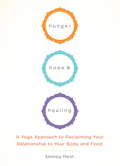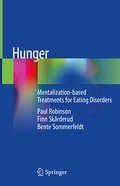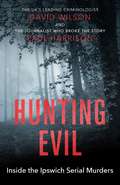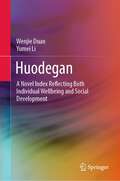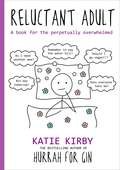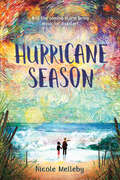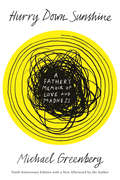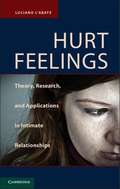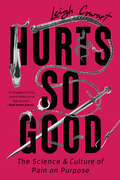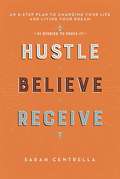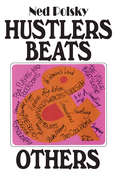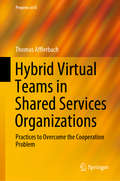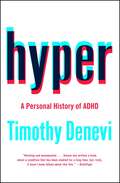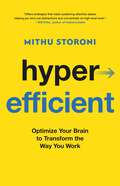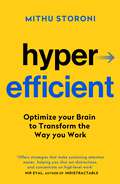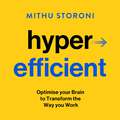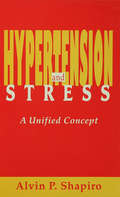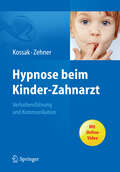- Table View
- List View
Hundegestütztes Coaching und Training: Effizient, wirkungsvoll und nachhaltig
by Manuela LentzschHunde bieten für Menschen als lebende, denkende und fühlende Lebewesen im Coaching und Training viele Mehrwehrte. Manuela Lentzsch erläutert in diesem Buch, warum gerade Hunde so wunderbare Co-Trainer sind und welche verschiedenen Rollen und Funktionen sie dabei einnehmen können.Das Buch zeigt neben den Grundlagen und den Wirkungsweisen von hundegestütztem Coaching und Training vor allem die Einsatzmöglichkeiten sowie Praxisbeispiele und konkrete Interventionen zur praktischen Anwendung auf. Die tiergestützten Übungen sind nach Persönlichkeits-, Führungskräfte- und Teamentwicklung unterteilt. Ein besonderes Augenmerk legt die Autorin neben dem klientenzentrierten auf einen tierzentrierten Ansatz, welcher dem Wohlbefinden des Hundes Rechnung trägt. Wichtige Aspekte der Qualitätssicherung sowie Auswahlkriterien beim Hund und tierschutzrelevante Gesichtspunkte werden daher in diesem Werk ebenfalls beleuchtet. Das Buch bietet einen fundierten Leitfaden für Menschen, die mehr überhundegestütztes Coaching und Training erfahren wollen.Die ZielgruppenCoaches, Trainern und Hundeerziehern eröffnet das Buch ein spannendes zusätzliches Geschäftsfeld und zeigt deren Wirksamkeit, Grenzen sowie Einsatzmöglichkeiten auf. Führungskräfte erfahren, welche Kompetenzen sie durch hundegestütztes Coaching und Training effizienter, wirksamer und nachhaltiger bei sich selbst, oder in ihrem Team stärken können. Hundehalter erhalten zudem Anregungen für die eigene Persönlichkeitsentwicklung mit ihrem Hund und können von einer verbesserten Mensch-Hund-Beziehung profitieren.
Hungarian Psychiatry, Society and Politics in the Long Nineteenth Century (Mental Health in Historical Perspective)
by Emese LaffertonThis book provides the first comprehensive study of the history of Hungarian psychiatry between 1850 and 1920, placed in both an Austro-Hungarian and wider European comparative framework. Taking an interdisciplinary approach, the book captures the institutional worlds of the different types of psychiatric institutions intertwined with the intellectual history of mental illness and the micro-historical study of everyday institutional practice. It uncovers the ways in which psychiatrists gradually organised themselves and their profession, defined their field and role, claimed expertise within the medical sciences, lobbied for legal reform and the establishment of psychiatric institutions, fought for university positions, the establishment of departments and specialised psychiatric teaching. Beyond this story of increasing professionalization, this study also explores how psychiatry became invested in social critique. It shows how psychiatry gradually moved beyond its closely defined disciplinary borders and became a public arena, with psychiatrists broadening their focus from individual patients to society at large, whether through mass publications or participation in popular social movements. Finally, the book examines how psychiatry began to influence the concept of mental health during the first decades of the twentieth century, against the rich social and cultural context of fin-de-siècle Budapest and the Austro-Hungarian Dual Monarchy.
Hunger Strike: The Anorectic's Struggle as a Metaphor for our Age
by Susie OrbachSusie Orbach is a psychotherapist arid writer. With Luise Eichenbaum she co-founded The Women's Therapy Centre in London in 1976 and in 1981 The Women's Therapy Centre Institute in New York. She lectures extensively in Europe and North America, is a visiting Professor at the London School of Economics, and has a practice seeing individuals and couples and consulting to organizations. She is a frequent contributor to newspapers and magazines, as well as to radio and television programmes. Her other books on eating problems are Fat is a Feminist Issue (1978), Fat is a Feminist Issue II (1982) and On Eating (2002). With Luise Eichenbaum she has written Understanding Women: A Feminist Psychoanalytic Account (1982), What do Women Want (1983) and Between Women (1988). She is also the author of What's Really Going on Here (1993), Towards Emotional Literacy (1999) and The Impossibility of Sex (1999).
Hunger for Connection: Finding Meaning in Eating Disorders
by Alitta KullmanWho develops which eating disorder and why? When do eating disorders begin and what fuels them? In Hunger for Connection, psychoanalyst and eating-disorder specialist Alitta Kullman expands on the "body/mind" personality organization she calls the "perseverant personality," illustrating how food and thought are linked from infancy, and for some, can become the primary source of nurturance and thought-processing for a lifetime—leading to what we call an eating disorder. Writing in a highly accessible style, Kullman brings humor and gentleness to her interactions with patients, offering health professionals and mainstream readers alike an essential guide to understanding and/or working with cyclical eating disorders of all types. From psychoanalysts, psychotherapists, and counsellors, to eating disorder specialists, researchers, and students, Hunger for Connection not only provides guidelines for therapists of varying theoretical orientations and levels of expertise, but help and hope to people suffering with eating disorders and those who care for and about them.
Hunger, Hope, and Healing
by Sarahjoy MarshA yoga approach to dealing with disorded eating patterns--like overeating, food addiction, and stress eating--and the resulting emotional distress they can cause. Yoga philosophy and practice are increasingly being used therapeutically to help people overcome disorded eating patterns--like overeating, food addiction, and stress eating--and the resulting emotional distress they can cause. Sarahjoy Marsh offers a program using yoga to address food-centered behaviors and body image issues. She illuminates the nature of addiction and offers a methodical approach to recovery that is neither dogmatic nor rigid; rather, it is compassionate, hopeful, and deliberate. Full of clear, empathic advice and photographs of the step-by-step practices, this book will help alleviate the isolation that people with food-oriented issues and body image problems feel; offer strategies for changing the behaviors; and give clear guidelines about the processes of recovery and the development of new life skills.
Hunger: Mentalization-based Treatments For Eating Disorders
by Paul Robinson Finn Skårderud Bente SommerfeldtThis work presents the adaptation of mentalization-based therapy for use in Eating Disorders (MBT-ED). The book starts with a presentation of the theoretical concept of mentalization and describes eating disorders from this perspective. This is followed by a discussion of the place of MBT-ED in eating disorders practice. MBT is first presented as the original model for borderline personality disorder, and then the model is further developed to address specific symptoms found in eating disorders, such as body image disturbance, restriction and purging. The original MBT model consists of outpatient treatment combined with individual and group psychotherapy, and psychoeducation in groups. The book then looks at supervision and training, and how an eating disorders team can develop a mentalizing focus. It goes on to describe the training required for practitioners to deliver individual and group MBT-ED and to supervise therapy. Lastly, it examines the implementation of the approach in different clinical settings, including inpatient services, and how management can be involved in negotiating barriers and taking advantage of enablers in the system. The authors have conducted a pilot randomized controlled trial and qualitative research in MBT-ED and have extensive experience in providing and supervising this novel therapy. MBT-ED is one of the few therapies for eating disorders that links theory of mind, and attachment and psychodynamic therapies and as such will be of great theoretical interest to a wide variety of clinicians and researchers.
Hunting Evil: Inside the Ipswich Serial Murders
by David Wilson Paul HarrisonDAVID WILSON'S NEW TRUE CRIME BOOK "A PLOT TO KILL" OUT NOW The definitive account of a national tragedy: by the journalist who broke the story and the UK's 'Number One Expert on Serial Killing' - with full details of the January 08 trialThe murder of five women in late 2006 shocked the nation and kept many of us glued to our TV screens, horrified by the unfolding tragedy. For the quiet town of Ipswich it was fifty days of fear and soul searching, from the disappearance of the first victim to the dramatic arrest of the lead suspect, Steve Wright. Journalist Paul Harrison and Professor of Criminology David Wilson arrived in Ipswich just as the first body was discovered. Their on-the-scene access, and Professor Wilson's first-hand experience as a profiler, meant that they were first to put forward the explosive theory that a serial killer was at large.In Hunting Evil, Harrison and Wilson take the reader to the heart of the story. Both visited the sites where the killer disposed of his victims' bodies; both walked the red light area of Ipswich; and both talked to those closest to the victims. They explore the reasons why someone will kill and kill again, and perhaps most important of all explain how serial killers target the must vulnerable in our society, and what can be done to make our communities safer for everyone.
Hunting Evil: Inside the Ipswich Serial Murders
by David Wilson Paul HarrisonBE THE FIRST TO READ DAVID WILSON'S NEW TRUE CRIME BOOK "A PLOT TO KILL" BY PRE-ORDERING NOWThe definitive account of a national tragedy: by the journalist who broke the story and the UK's 'Number One Expert on Serial Killing' - with full details of the January 08 trialThe murder of five women in late 2006 shocked the nation and kept many of us glued to our TV screens, horrified by the unfolding tragedy. For the quiet town of Ipswich it was fifty days of fear and soul searching, from the disappearance of the first victim to the dramatic arrest of the lead suspect, Steve Wright. Journalist Paul Harrison and Professor of Criminology David Wilson arrived in Ipswich just as the first body was discovered. Their on-the-scene access, and Professor Wilson's first-hand experience as a profiler, meant that they were first to put forward the explosive theory that a serial killer was at large.In Hunting Evil, Harrison and Wilson take the reader to the heart of the story. Both visited the sites where the killer disposed of his victims' bodies; both walked the red light area of Ipswich; and both talked to those closest to the victims. They explore the reasons why someone will kill and kill again, and perhaps most important of all explain how serial killers target the must vulnerable in our society, and what can be done to make our communities safer for everyone.
Huodegan: A Novel Index Reflecting Both Individual Wellbeing and Social Development
by Wenjie Duan Yumei LiThe core of this book is the concept of huodegan (获得感), which refers to a sense of gain that includes perceived individual wellbeing and social development. Given that measuring sense of gain has become critical in the new era of socialism with Chinese characteristics and along with the social indicators movement in the last decade, building an index for evaluating sense of gain becomes critical. Apart from reviewing the existing index systems for social development and policy and the previous studies exploring the sense of gain, this book highlights the importance of combining Chinese socio-cultural features, established theories, and index systems.
Hurrah for Gin: A book for the perpetually overwhelmed (Hurrah for Gin #3)
by Katie KirbyPerpetually overwhelmed? Welcome to the new book from Katie Kirby, creator of the bestselling Hurrah for GinDo you overthink everything? Do you struggle to say no to people? Are you paying membership for a gym you never go to? Do group chat politics make you want to throw your phone under a bus? Are you overjoyed when people cancel plans so that you can sit at home in your pyjama bottoms eating Coco pops for dinner? If so then this book is for you!We spend our childhoods wanting to a be adults and, when we get there, find ourselves lost under a pile of life admin, half completed to do lists and anti-ageing face creams that promise to make you look as good as Natalie Imbruglia. In her new book, Hurrah for Gin pinpoints with painful precision just how overwhelming life can be when you're all grown up. From the worry spiral that keeps you up at 3AM, to maintaining a professional aura when you can't stand other people - this is for everyone struggling to stay afloat. Honest, relatable, funny and containing no useful advice whatsoever, take comfort in the knowledge that it's not just you, we're all as f*cked as each other.
Hurricane Season
by Nicole MellebyFor Fig’s dad, hurricane season brings the music.For Fig, hurricane season brings the possibility of disaster. Fig, a sixth grader, loves her dad and the home they share in a beachside town. She does not love the long months of hurricane season. Her father, a once-renowned piano player, sometimes goes looking for the music in the middle of a storm. Hurricane months bring unpredictable good and bad days. More than anything, Fig wants to see the world through her father’s eyes, so she takes an art class to experience life as an artist does. Then Fig’s dad shows up at school, confused and looking for her. Not only does the class not bring Fig closer to understanding him, it brings social services to their door. As the walls start to fall around her, Fig is sure it’s up to her alone to solve her father’s problems and protect her family’s privacy. But with the help of her best friend, a cute girl at the library, and a surprisingly kind new neighbor, Fig learns she isn’t as alone as she once thought . . . and begins to compose her own definition of family. Nicole Melleby’s Hurricane Season is a radiant and tender novel about taking risks and facing danger, about friendship and art, and about growing up and coming out. And more than anything else, it is a story about love—both its limits and its incredible healing power.
Hurry Down Sunshine: A Memoir
by Michael GreenbergIn this extraordinary account of a loved one's madness and the effects it has on family, friends, caregivers and even fellow sufferers, Greenberg records his daughter Sally's journey as only a father can while still remaining completely honest with her and himself. <P><P>Even random comments by near-strangers become significant here, and as Sally struggles in an institution and again under outpatient care Greenberg makes it clear that as a family, community and society we share more madness than we dare to admit. His description of Sally's progress toward coherence through work in theater is especially moving. Annotation
Hurt Feelings: Theory, Research, and Applications in Intimate Relationships
by Luciano L'AbateHurt feelings are universal and are present in human beings as well as in animals. These feelings are usually avoided by human beings and overlooked by the scientific and professional mental health communities. Yet, if unresolved and not shared with loved ones and professionals, they tend to fester in our bodies and effect our functioning. If not expressed and shared with caring others, anger, sadness and fear are at the bottom of mental illness. Developmentally, each of these feelings respectively gives rise to antisocial acts, depression and severe mental illness. This book suggests that instead of traditional one-on-one, face-to-face, conversation-based interventions, distance writing will allow mental health professionals to assign interactive practice exercises specifically focused on hurt feelings.
Hurts So Good: The Science and Culture of Pain on Purpose
by Leigh CowartAn exploration of why people all over the world love to engage in pain on purpose--from dominatrices, religious ascetics, and ultramarathoners to ballerinas, icy ocean bathers, and sideshow performersMasochism is sexy, human, reviled, worshipped, and can be delightfully bizarre. Deliberate and consensual pain has been with us for millennia, encompassing everyone from Black Plague flagellants to ballerinas dancing on broken bones to competitive eaters choking down hot peppers while they cry. Masochism is a part of us. It lives inside workaholics, tattoo enthusiasts, and all manner of garden variety pain-seekers. At its core, masochism is about feeling bad, then better—a phenomenon that is long overdue for a heartfelt and hilarious investigation. And Leigh Cowart would know: they are not just a researcher and science writer—they&’re an inveterate, high-sensation seeking masochist. And they have a few questions: Why do people engage in masochism? What are the benefits and the costs? And what does masochism have to say about the human experience? By participating in many of these activities themselves, and through conversations with psychologists, fellow scientists, and people who seek pain for pleasure, Cowart unveils how our minds and bodies find meaning and relief in pain—a quirk in our programming that drives discipline and innovation even as it threatens to swallow us whole.
Hustle Believe Receive: An 8-Step Plan to Changing Your Life and Living Your Dream
by Sarah CentrellaIn Hustle Believe Receive, Sarah Centrella, author of the internationally popular blog Thoughts. Stories. Life. , proves that anyone, no matter where they start from, can change their life, achieve success, and live their dream. As a single mom living on food stamps, Sarah completely changed her life of poverty to enable her to live her dream in just eighteen months. Sarah discovered the tools to change her life after her husband abandoned her and their three small children in 2008. Her story has impacted hundreds of thousands worldwide, through her simple eight-step plan for achieving success known as the #HBRMethod. The book features fifty-one inspiring stories of people who believe in Sarah’s message, each of whom she personally interviewed for this book. They include: NFL star running back, Jonathan Stewart; NBA power forward Anthony Tolliver; famed artist Victor Matthews; best-selling author Laura Munson; middle weight world boxing champion, Daniel Jacobs; CEO, Ryan Blair; and Morgan Stanley executive director Kimberley Hatchett, among many others. Hustle Believe Receive shows how these stories are connected, and how Sarah, a single mom from Oregon, manages to bring them all together in the most unlikely way. Hustle Believe Receive contains true tales of how real people are living the impossible. This book answers the question of "How did they do that?” and, more importantly, how you can too.
Hustlers, Beats, and Others
by James W. VanStoneRanging from pool hustling to pornography, this book analyzes deviant branches of American life, dispels misconceptions about them, and throws new light on sociological theory and method. Each chapter radically dissents from one or more mainstream opinions about deviance.The first chapter examines the alleged causes for the decline of American poolrooms and finds them wanting, traces the rise and fall of poolrooms to historical changes in America's social structure, and cogently dissects the recent poolroom revival. The second chapter, reports a field study of a deviant occupation, pool hustling, describing the hustler's work situation and career from recruitment to retirement. In revealing how pool hustlers, although dedicated wholly to a vocation that merely breaks unenforced gambling laws, frequently supplement their income by means of outright felonies, the author develops a new theory of "crime as moonlighting." The third chapter sharply criticizes our criminology textbooks for avoiding the study of uncaught adult criminals in their natural environments. It demonstrates such research to be both necessary and practical with career felons as well as moonlighters. The author describes field techniques he has used with career felons, offers new findings gleaned by means of these techniques, and answers moral objections to such research. The forth chapter presents the first genuinely empirical study of the beat delinquent sub-culture, in which the author corrects some journalistic views such as that most beats are exhibitionists and some sociological ones such as that "retreatist" drug-users can meet neither legitimate nor criminal success norms. The final chapter, on the sociology of pornography, holds that the courts are wrong to claim that naturalistic erotic art is non-pornographic, and wronger still to claim that hard-core pornography is, in Mr. Justice Brennan's words, "utterly without redeeming social importance."The author's unusual blend of
Hybrid Virtual Teams in Shared Services Organizations: Practices to Overcome the Cooperation Problem (Progress in IS)
by Thomas AfflerbachThis book focuses on virtual teams, which are fraught with cooperation problems. It offers novel insights into how team members experience and overcome these problems by empirically studying hybrid virtual teams in Shared Services Organizations. It firstly enhances the reader’s understanding of contextual challenges relating to cooperation and shows how members of such teams experience faultlines through distance, disconnection through reliance on communication technology and discontinuity through temporality of team composition. Secondly, it explores how they use 22 practices to overcome the cooperation problem, which can be categorized as strategies of identity constructing, trusting and virtual peer monitoring. Lastly, the study analyzes the role of technology, demonstrating that state-of-the-art media can facilitate, but not ensure the use of these strategies and practices. As such, the book has implications for both researchers and practitioners.
Hydrofeminist Thinking With Oceans: Political and Scholarly Possibilities (Postqualitative, New Materialist and Critical Posthumanist Research)
by Vivienne Bozalek Tamara Shefer Nike RomanoHydrofeminist Thinking with Oceans brings together authors who are thinking in, with and through the spaces of ocean/s and beaches in South African contexts to make alternative knowledges towards a justice-to-come and flourishing at a planetary level. Primary scholarly locations for this work include feminist new materialist and post-humanist thinking, and specifically locates itself within hydrofeminist thinking. Together with a foreword by Astrida Neimanis, the chapters in this book explore both land and water with oceans as powerfully political spaces, globally and locally entangled in the violences of settler colonialism, land dispossession, slavery, transnational labour exploitation, extractivism and omnicides. South Africa is a productive space to engage in such scholarship. While there is a growing body of literature that works within and across disciplines on the sea and bodies of water to think critically about the damages of centuries of colonisation and continued extractivist capitalism, there remains little work that explores this burgeoning thinking in global Southern, and more particularly South African contexts. South African histories of colonisation, slavery and more recently apartheid, which are saturated in the oceans, are only recently being explored through oceanic logics. This volume offers valuable Southern contributions and rich situated narratives to such hydrofeminist thinking. It also brings diverse and more marginal knowledges to bear on the project of generating imaginative alternatives to hegemonic colonial and patriarchal logics in the academy and elsewhere. While primarily located in a South African context, the volume speaks well to globalised concerns for justice and environmental challenges both in human societies and in relation to other species and planetary crises. The chapters, which will be of interest to scholars, activists and other civil society stakeholders, share inspiring, rich examples of diverse scholarship, activism and art in these contexts, extending international scholarship that thinks in/on/with ocean/s, littoral zones and bodies of water. The book offers ethico-political perspectives on the role of research in ocean governance, policy development and collective decision-making for ecological justice. This book is suitable for students and scholars of post-qualitative, feminist, new materialist, embodied, arts-based and hydrofeminist methods in education, environmental humanities and the social sciences.
Hyper: A Personal History of ADHD
by Timothy DeneviThe first book of its kind, this compelling and moving memoir about what it's like to be a child with ADHD also explains the history of the diagnosis and how we have come to medicate more than four million children today.Among the first generation of boys prescribed medication for hyperactivity in the 1980s, Timothy Denevi took Ritalin at the age of six, and during the first week, it triggered a psychotic reaction. Doctors recommended behavior therapy, then antidepressants. Nothing worked. As Timothy's parents and doctors sought to treat his behavior, he was subjected to a liquid diet, a sleep-deprived EEG, and bizarre behavioral assessments before finding help in therapy combined with medication. In Hyper, Timothy describes how he makes his way through school, knowing he is a problem for those who love him, longing to be able to be good and fit in, hanging out with boys who have similar symptoms but meet different ends, and finally realizing he has to come to grips with his disorder before his life spins out of control. Skillfully and seamlessly using his own experience as a springboard, Denevi also reveals the origins of ADHD, from the late nineteenth century when hyperactivity was attributed to defective moral conscience, demons, or head trauma, through the twentieth century when food additives, bad parenting, and even government conspiracies were blamed, to the most recent genetic research. He traces drug treatment from Benzedrine in 1937 through the common usage of the stupefying chlorpromazine and brand new Ritalin in the 1950s to the use of antidepressants in the 1970s, 1980s, and 1990s. Riveting, thought-provoking, and deeply intelligent, this is a remarkable book both for its sensitive portrait of a child's experience as well as for its ability to illuminate a remarkably complex and controversial mental condition. Rick Lavoie, author of It's So Much Work to Be Your Friend, says Hyper is "a significant and singular contribution to our field."
Hyperbaric Oxygen Therapy: Principles and Applications
by Manoj Gupta Indumathi SomasundaramThis book covers the hyperbaric oxygen therapy (HBOT) in current recommended indications, emphasizing the mechanisms involved in the benefits of supplemental oxygen under high pressure. The physiological changes associated with high pressure and hyperoxic conditions are discussed in initial chapters, along with their physical basis governed by the laws of gas followed by the functioning of hyperbaric chambers and the safety precautions needed in operating them. Utilization of HBOT in indications such as wound healing, severe anemia, and burn injuries is thoroughly explained, along with the recommended protocol for HBOT administration. The final chapters present the contraindications of HBOT and its promising effects on aging and regeneration.This book is helpful to HBOT practitioners in understanding its underlying mechanism and major applications.
Hyperefficient: Optimize Your Brain to Transform the Way You Work
by Mithu StoroniOptimize your life using science-backed advice and discover how to get your brain working at peak efficiency. We all know how to nudge our brains to perform better. A strong cup of coffee helps us get through a dull meeting, and a brisk walk helps us think more clearly. But what if some nudges could optimise how we focus, create and process information even more effectively, to take mental performance to new heights? Today, most office workers are expected to operate with industrial-era efficiency. Yet the work that matters most in our technology-dominated workplace – generating brilliant ideas, solving complex problems, and learning – can&’t be manufactured like outputs on an assembly line. Instead, we need a new, HYPEREFFICIENT way of working: rather than imposing the rhythms of work on our brains, Dr. Mithu Storoni proposes we impose the rhythm of our brains on our work. Storoni explains that our brains function like a car&’s engine, with multiple gears that put our brains in optimal mode for different mental challenges. Drawing on the latest research, she shows us how to seamlessly shift our brains into the best gear for the tasks we need to be doing, so we can perform at our best throughout the day, every day.
Hyperefficient: Simple Methods to Optimise your Brain and Transform the Way you Work
by Mithu Storoni'Read this book! Mithu Storoni's unique strategy doesn't just preserve brain health and longevity, it promises to escalate mental performance to new heights and improve the way we work.' - Dan Buettner, National Geographic Fellow and #1 New York Times Bestselling author of the Blue Zones.Take back control. Optimize your brain. Become hyperefficient.In today's digital age, we move through life at a frantic pace to keep up with the never-ending influx of information and daily tasks. But what if some simple shifts could help boost creativity and optimise how we focus and process data, to elevate our mental performance and productivity?In Hyperefficient, Dr Mithu Storoni lays out the tools to retune our brains to the best settings for complex thinking, concentration, and decision-making. Storoni proposes we impose the rhythm of our brains on our work in order to create the perfect environment for us to thrive individually at work and at home. Rooted in the very latest scientific research, Hyperefficient is a must-have practical manual for your brain.
Hyperefficient: Simple Methods to Optimise your Brain and Transform the Way you Work
by Mithu Storoni'Read this book! Mithu Storoni's unique strategy doesn't just preserve brain health and longevity, it promises to escalate mental performance to new heights and improve the way we work.' - Dan Buettner, National Geographic Fellow and #1 New York Times Bestselling author of the Blue Zones.Take back control. Optimize your brain. Become hyperefficient.In today's digital age, we move through life at a frantic pace to keep up with the never-ending influx of information and daily tasks. But what if some simple shifts could help boost creativity and optimise how we focus and process data, to elevate our mental performance and productivity?In Hyperefficient, Dr Mithu Storoni lays out the tools to retune our brains to the best settings for complex thinking, concentration, and decision-making. Storoni proposes we impose the rhythm of our brains on our work in order to create the perfect environment for us to thrive individually at work and at home. Rooted in the very latest scientific research, Hyperefficient is a must-have practical manual for your brain.
Hypertension and Stress: A Unified Concept
by Alvin P. ShapiroUnderstanding and treating hypertension has progressed significantly during the past 40 to 50 years. This progress has made a major contribution to health care concerns such as quality of life, prevention of disability, and mortality. In the past, hypertension and hypertensive disease had been a "silent scourge," but it is presently an industry. Research on hypertension has expanded into a variety of fields including epidemiology, endocrinology, surgery, pharmacology, and behavioral medicine. Therapeutic accomplishments have made hypertension a leading source of income for the pharmaceutical industry; the field of clinical pharmacology originated with the development of drugs to treat hypertension. Increasingly, specific drugs to treat specific mechanisms which raise blood pressure have moved from the laboratory to the bedside. A constant awareness has been present that emotional stress, both from within the individual as well as from environmental sources, plays a role in the "three Ps" -- predisposition, precipitation, and perpetuation -- of hypertension. Arguments range from stating that such stress may be the major cause of at least some forms of hypertension, to allowing that although some effect is present from stress, it is only a minor perturbation of no significance in the overall pattern of the disease. Advocates of stress theory may be biased by a lack of detailed knowledge or experience with the physiology and biochemistry involved in the establishment of this disorder. On the other hand, those who deny the importance of stress factors may be unaware of the large body of data that indicate the role of these factors in any comprehensive understanding of hypertension. Following the Mosaic Theory, this book's approach to hypertension shows that multiple factors can be invoked in understanding the etiology and management of hypertension, where the strength of individual factors vary depending on genetic background, acquired diseases, and environmental influences. Stress can be involved in predisposition by affecting a genetically programmed person, in precipitation by supplying the stimulus to bring the disease to a clinical level, and in perpetuation by maintaining or exacerbating the clinical disease. This volume attempts to integrate what is known about the effects of stress on blood pressure with the overall mosaic of hypertension making use of the aforementioned "three Ps" as part of the framework for this integration.
Hypnose beim Kinder-Zahnarzt
by Hans-Christian Kossak Gisela ZehnerSchluss mit Zahnarztphobie bei Kindern Kinder sind beim Zahnarztbesuch oft unkooperativ und stellen in der Alltagspraxis eine hohe Herausforderung für das Praxisteam dar. Der damit verbundene Stress und die Angst der Kinder vor unangenehmen Erlebnissen werden mit der Anwendung von Kinderhypnose signifikant reduziert. Experten für Experten Die beiden Autoren sind bekannte Experten für Kinderhypnose und bringen ihre Erfahrungen als Kinderzahnärztin und Kinder- und Jugendlichenpsychotherapeut ein. Sie vermitteln wissenschaftlich fundierte Behandlungs- und Kommunikationsmethoden der Kinderhypnose, mit der hierzu speziell entwickelten Quick-Time-Trance und Kombinationen mit anderen Methoden (Akupressur, energetische Psychologie). Die Verhaltensführung und Behandlung beim Zahnarzt wird dadurch tatsächlich kinderleicht, da die Kinderhypnose auch dauerhafte positive Einstellungen zum Zahnarztbesuch vermittelt. Geschrieben für Zahnärzte, Kinderzahnärzte, Psychologen, Kinder- und Jugendlichenpsychotherapeuten, zahnärztliche Mitarbeiterinnen. Mit Online-Videobeispielen: zahlreiche Falldemonstrationen und Erklärungen zu den Methoden
